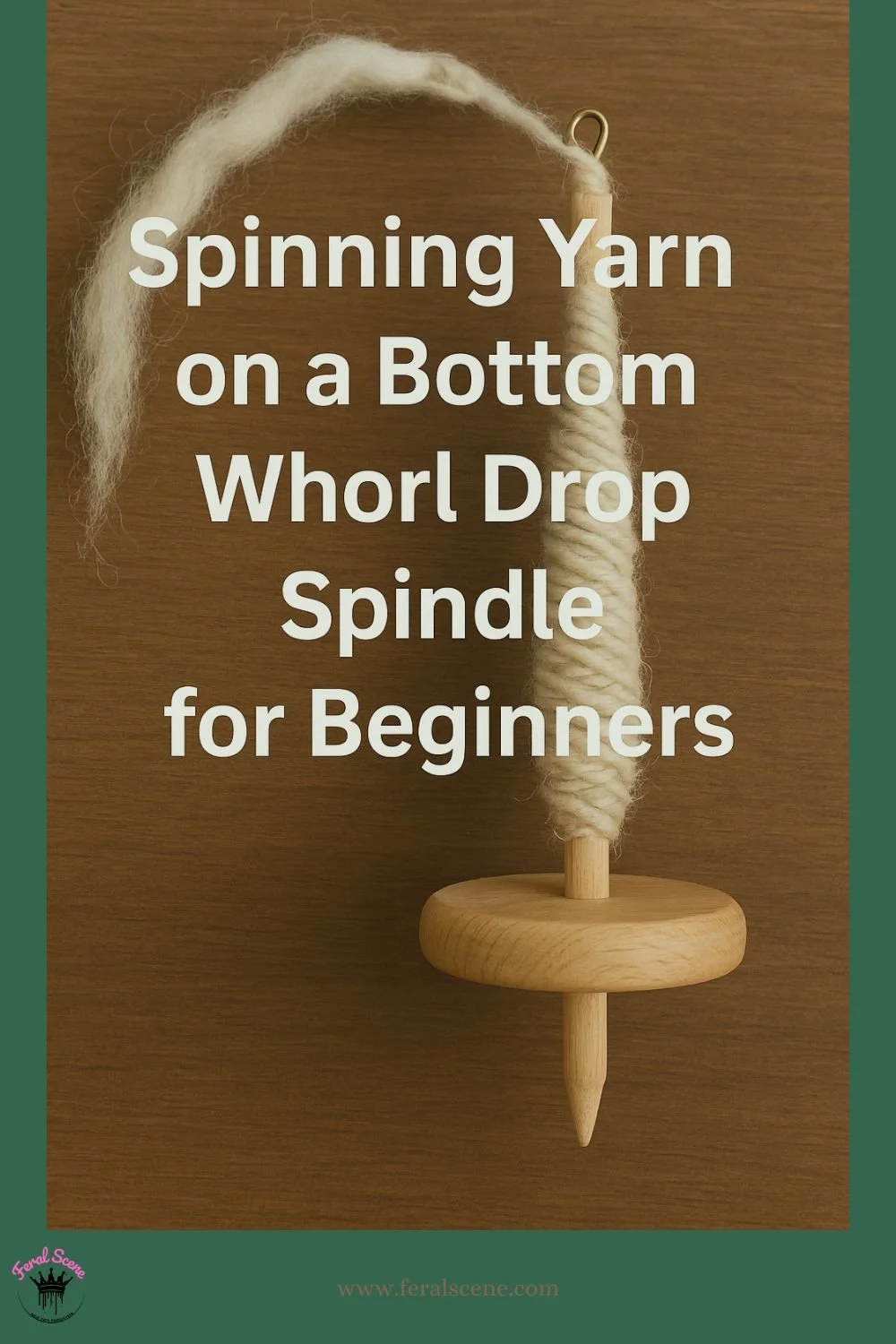Spinning Yarn on a Bottom Whorl Drop Spindle for Beginners
There’s something quietly powerful about creating your own yarn from nothing but fluff and a simple wooden tool. Spindle spinning is one of the oldest fiber arts — and it’s still one of the most accessible ways to start your spinning journey today. Whether you’re here from YouTube or just curious about how spinning works, this guide will walk you through everything you need to know to get started with a bottom whorl drop spindle — no prior experience required.
I must admit most of my drop spindle content is filmed and spun on a top whorl drop spindle. It’s what my very first spindle happened to be and I’m a creature of habit. For this reason I didn’t really dive into the world of bottom whorl drop spindles for years until a friend made batch and sent me a present. I don’t really think there’s too many benefits of a bottom whorl over a top whorl except that you may enjoy the weight distribution and spinning feeling. Like most things you’ll probably always prefer whatever it is you learned on. I filmed this video for my YouTube Channel years ago and wanted it to have a permanent place on the internet in the form of a blog. I have included some basic tips but like most of my teaching I feel that video lessons and showing techniques are key. Please don’t miss the video below. If you’ d like further fiber arts instruction please peruse my courses.
What Is a Bottom Whorl Drop Spindle?
A drop spindle is a handheld spinning tool that uses gravity and twist to transform fiber into yarn. The “bottom whorl” refers to the weighted disc sitting near the bottom of the shaft — which gives the spindle momentum as it spins and helps keep the yarn building evenly.
Think of it like this:
Top whorl: the weight is near the top, usually better for finer yarns.
Bottom whorl: the weight is near the bottom, better for beginners because it spins longer and more steadily.
Bottom whorl spindles are straightforward, reliable, and easy to learn on — especially if you’re just dipping your toes into spinning.
Why Start with a Drop Spindle?
If you’ve been eyeing spinning wheels but aren’t ready to make the investment, a drop spindle is your low-risk, high-reward entry point.
Here’s why beginners love it:
🧶 Affordable — you can usually get started for under $30.
💼 Portable — toss it in your bag and spin anywhere.
🧘♀️ Mindful — the pace is slower, which helps you actually feel the twist and draft.
Learning on a drop spindle gives you a deep understanding of fiber twist, drafting tension, and yarn structure — all foundational skills for leveling up to a spinning wheel later (which I also cover in my Dream Yarn course).
What You’ll Need to Get Started
Here’s your basic spindle starter pack:
A bottom whorl drop spindle (wooden, basic is fine)
Wool roving or top — something easy to draft, like Rambouillet or Targhee (I offer curated fiber kits [here] with beginner-friendly blends)
A sense of curiosity and a little patience
Optional:
A small hook or notch at the top of the spindle (many spindles come with this)
A leader yarn to get your first bit of twist going (you can also spin directly onto fiber, but beginners often like having a head start)
Step-by-Step: How to Spin Yarn on a Bottom Whorl Spindle
(Watch the full video tutorial below — and then follow along with the steps!)
Quick Breakdown:
Attach your fiber to the leader yarn (or straight to the spindle if you're skipping the leader).
Spin the spindle clockwise with your fingers to add twist.
Draft your fiber slowly, letting the twist travel up into it.
Wind on the yarn you’ve made, forming a neat cop (the ball of yarn on the shaft).
Repeat! The rhythm will come naturally with time.
Don’t worry if your first attempts look like funky yarn noodles — that’s exactly what’s supposed to happen.
Common Beginner Tips
Start with thick fiber — it's more forgiving and easier to draft.
Pre-draft your roving — loosen it up a bit before spinning.
Practice without fiber — just spin the spindle and get a feel for the motion first.
Let the twist build — don’t rush to draft. Twist is your friend.
What Comes Next?
Once you’re comfortable making singles (one strand of yarn), you can try:
Plying two singles together for stronger, balanced yarn.
Experimenting with fiber types — silk blends, longwools, etc.
Joining a spinning community or learning more in my Dream Yarn course, which breaks down how to get consistent results and explore your style as a spinner. Or expand your knowledge of a drop spindle with my Drop Spindle 101 Course
Want to Go Deeper?
If this tutorial got your wheels turning (pun intended), here are some next steps:
Get a beginner-friendly fiber kit from my shop — curated specifically for spindles.
Join my Yarn Craft Collective to get spinning tips, resources, and behind-the-scenes updates.
Enroll in my Dream Yarn course if you're ready to get serious about your spinning journey and go from beginner to confident artist.
Final Thoughts
Spinning yarn on a drop spindle isn’t just a craft — it’s a kind of meditation, empowerment, and connection to tradition. Once you feel the rhythm of twist and draft, it becomes addictive in the best way. So take your time, enjoy the process, and welcome to the world of handspun.

